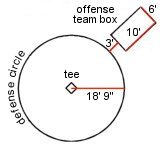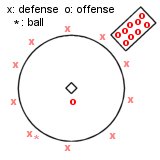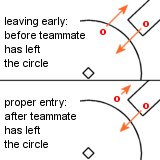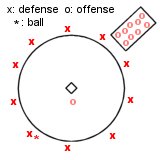|
Section 1: Game Setup
1.1 Field Setup
a. The playing field consists of a defense circle, with a radius of 18 feet, 9 inches*, around a central point where a tee is placed.
b. The defense circle can be marked with field liner for semi-permanent outdoor use, or with polyspots or short cones for temporary outdoor and indoor use.
c. The offense team box should be should be 6 feet wide and 10 feet deep. It should be set back from the defense cirle by 3 feet.
d. The playing field should be in an open area with as few obstructions as possible. Recommended space is at least 60 feet x 60 feet; optimal space is 100 feet x 100 feet or more if available. * Also known as 3 Joe. One Joe (the guy we used to mark out the toppleball circle for several years) is 6 feet, 3 inches. |
 |
| 1.2 Equipment
a. The central tee should have a spring-loaded base and a whiffle ball on top.*
b. Batters hold a flat paddle, similar in size to a cricket bat (but wider and not curved).
c. A standard-weight beach volleyball for the defense should be used when playing outdoors.** If indoor space is limited, or if playing with younger children, an 8-inch Rhinoskin ball can be substituted. * The spring for our camp tee broke in 2004, so some photos will show a base with a whiffle ball bat instead. This is an acceptable substitute, as is any standard batting practice tee on which a whiffle ball can be set.
** The ball we use has some padding, which reduces hit distance a bit, and lessens how much it hurts if you are accidentally hit with the ball. |
|
|
1.3: General Game Play
a. Games last for a time limit agreed upon by both teams.
b. Teams switch from defense to offense (and vice versa) if the whiffle ball falls off of its tee due to any factor except wind.*
c. Games should be mediated by at least one referee, who is in charge of keeping score, the game clock (typically a watch with a timer function), and calling penalties. referees should decide how to account for outside influences on game play, including but not limited to spectators and obstacles near the playing field. * If using a whiffle ball bat as a tee, teams switch if the bat visibly moves due to any factor except wind. |
|
|
Section 2: Offense
2.1 Positions
a. One member of the offense (the "batter") holds the toppleball paddle and stands inside the defense circle, attempting to prevent the defense from hitting the tee.
b. The remaining players on offense stand in the offense team box, outside the defense circle.
c. Players on offense that are not batting must stay inside the team box, except:
- when entering the defense circle to bat;
- when any timeout has been called;
- when teams switch from offense to defense.
d. Players on offense must remain in the same batting order for the duration of the game. |
 |
|
2.2 Scoring
a. A run is initiated when the batter exits the circle in the direction of the team box and another player on offense enters the circle.
b. A player entering the circle must wait for the exiting batter to cross the circle line before leaving the team box.
- Leaving the team box early during a normal scoring play will result in the nullification of that run.
- Leaving early during a batter change (see rule 2.3g) will result in a free throw for the defense.
c. The entering player, now the batter, must touch the base of the tee with either a hand or a foot before a run can be added to the team's score.
d. Players can score runs without touching the toppleball paddle; touching the base of the tee is the only requirement for scoring.
e. Runs can be scored in a continuous sequence, as long as there is only one player inside the defense circle at a time. |
 |
|
2.3 Batting
a. The batter may leave the defense circle to initiate a score unless the ball is stationary inside the circle, there is a stoppage of play, or the ball is considered dead (see rule 2.3e). For example:
- The batter has touched the ball with a body part or the paddle, and the ball has failed to fully exit the circle.
- The ball has been thrown/dropped/deflected into the circle by the defense and has failed to fully exit the circle.
- A team or referee has called a time out.
In the case of i., the batter must tap the ball out of the defense circle to a defender. In the case of ii., the batter must kick or hit the ball out of the circle before exiting.
b. The batter may use any body part (arms, legs, feet, etc.) to hit the ball, and may also use the paddle to hit the ball.
c. The batter may not catch or throw the ball.
d. The batter may not kick or hit the ball if it is touching or has corssed to the outside of the defense circle line.
e. The batter has one touch in which to hit or kick the ball out of the circle for each time the ball enters the circle after being touched by the defense (via a throw, drop, pass, etc.). If the batter touches the ball with either the bat or any body part and the ball fails to fully exit the circle, the ball is considered dead and must be tapped out of the circle to a defender. - Any ball leaving the circle as a result of incidental double contact (e.g. ricochet off of the bat and then the foot) is also considered dead, and no runs may be scored.
- If incidental double contact leads to the defense catching a fly ball (see rule 2.3g), a batter change is still mandatory.
f. The batter is allowed to block the ball as many times as necessary to prevent the ball from hitting the tee (e.g. in case of a ball that bounces back towards the tee after the initial contact). After one touch, the ball is considered dead as in rule 2.3e and must be tapped out.
g. If the defense catches a ball that has touched any body part of the batter or has touched the paddle but has not yet touched the ground (a fly ball), the batter must exit the circle and the next batter must enter. This is called a batter change, and no run is scored for that exchange of players.
h. Batters typically defend the tee, using a traditional baseball stance, to prevent the defense from hitting it and initiating a team switch. The batter may not defend the tee in the following ways: - standing with legs and/or torso directly in line between the ball and the tee.
- obscuring the tee with a vertically-oriented paddle.
- movement in an attempt to block the ball that involves a weight shift ito the line between the ball and the tee, even after the ball has been released (e.g. lunging to block with a knee).
Defending the tee in any of these ways is considered "blocking," and is penalized by awarding an open, free throw at the tee by the defender holding the ball at the time of the penalty.
i. Batters must "give a lane" (provide a clear path between the ball and a majority of the tee) for the defense at all times, including: - when the batter does not have possession of the paddle.
- when the batter is moving to defend the tee against another defender after a pass is thrown.
- when the batter is entering the circle after a run or a batter change.
Any blocking penalty called during these situations will result in a free throw for the defense. |
|
|
Section 3: Defense
3.1 Positions
a. The defense is spread out along the outside of the defense circle line.
b. The defense may not send players away from the defense line for the purpose of catching fly balls. All defenders must play in close proximity to the circle line unless chasing a ball after contact.
c. Defenders may not step, kneel, or place a hand(s) on the ground inside the circle line for any reason during game play. A defender may reach into the circle as long as no body parts tought the ground inside the circle line. A line violation results in a free kick for the batter, with the ball placed inside the circle line. |
 |
|
3.2 Defense Play
a. The goal for the defense is to hit the tee and cause the whiffle ball to fall. This initiates a team switch, allowing the defense to bat, and forcing the team on offense to play defense
b. The defense may not hide the ball during team changes.
c. During team switches, the defense must wait for the batter to get set in the circle and for the referee to signal the start of play before attempting to hit the tee. Readiness for play is at the discretion of the referee.
d. No member of the defense may hold the ball intentionally for more than five seconds during play, as this constitutes an unfair advantage for the defense. Within the five seconds, the defender must pass or attempt to hit the tee with the ball. Violation of this rule is at the discretion of the referee, and will result in time stoppage, a free run for the offense and the option of switching batters. If a holding penalty is called, the defender must also pass the ball to a teammate before the play clock can resume. |
|




